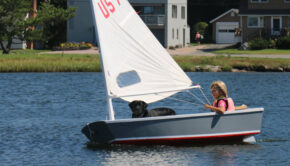Kite skiing on Georgian Bay
Published on January 17th, 2022
Andrew Manwaring can’t think of anything he’d rather be doing. Andrew’s wife, Colleen, feels exactly the same, but maybe not quite at that speed. The smiles on their faces and glints in their eyes shows how much they love winter kite flying season.
Gliding over the snow or ice with little to no resistance is a very unique winter experience. Kite skiing offers the adventurous another way of being in one’s element. Add a rush of adrenaline and an appreciation and respect for Mother Nature, and it’s also just plain fun.
Andrew and Colleen have been doing this for about 15 years, Colleen started to do lessons on the water and kite buggying. A kite buggy is a three-wheeled, low-seated contraption where the driver is hooked up to the kite harness. (Picture a GT Snowracer with fat tires.) She has moved into almost full-time kite skiing.
“Andrew is more like a pro. He goes very fast.”
Andrew and Colleen met down at the Salt Docks on the Big Sound in Ontario, as Andrew was kite skiing and Colleen was kite buggying. They have a two-year-old son now, so getting out is a little more complicated, but absolutely doable.
“I can go in all conditions, slush, deep snow, pure ice,” explains Andrew. “I can go across it all in any wind conditions. I can get ‘air’ when I want to or need to. Getting over a pressure crack or short pieces of water, I can skip across. When you get up to 80, 90 kilometres an hour I can get across it, or jump a pressure crack.”
When asked about ‘puddle jumping’ (as snow machines sometimes do over open water) Andrew says there isn’t enough consistent power to go across longer pieces of water.
Andrew sharpens his and Colleen’s edges on their skis so that they get a better angle when leaning way back – it’s a different angle than you would get on a regular ski. Colleen says she feels like she is still a beginner; however, she definitely holds her own. (Andrew chimed in that she’s more of an intermediate.)
“I always get that healthy dose of fear before I launch my kite,” Colleen admits. “I want to make sure that I am properly attached with all my safety gear on – I’m always checking around. I don’t go close to shore where Andrew does – I can’t turn on a dime – and I don’t like to go up in the air like Andrew does. I still feel like a beginner who has lots to learn.”
The perfect day for the couple involves 45 to 50 kilometre per hour west winds (22-27 knots). Sunshine also helps.
“I prefer a nice hard crust on the snow,” says Colleen, “whereas Andrew prefers glare ice.” (The ice is much faster.) “Andrew flies at a much steeper angle than I do. He can really catch his edges.” There is more speed the lower the kite is to the ground, hence angles and lean equals speed.
“Doing crosswind tacks is the same theory as sailing,” notes Andrew.
“The sport is based on patience and weather,” says Colleen. “It changes so much every year. Some years we have been able to start in December.”
Andrew runs different kites depending on the wind. “You’d think you would want a bigger kite to go faster, but in reality you need a bigger kite in smaller winds, to catch more available wind.
“In higher winds, you want to go with a smaller kite, because it’s more controllable. In 80 to 90 kph winds (43-49 knots) I use a one-metre square kite. A big kite in a strong wind can be dangerous.”
Part of the science is knowing what size to fly. Colleen is using a Concept Air Kite, a Canadian brand. With this particular kite she says, “you can change the kite size, as it can be controlled by pulling a certain string, expanding or contracting the size.” She likes the simplicity of it and it is less gear to haul around.
Andrew has that type as well as a number of other kites. “You want the kite to do the work, not your body! I usually take two or three kites with me. If the wind changes, it’s good to have options.”
“Andrew brings some ice climbing gear, ice screws, which allows you to secure your kite when the lines get twisted. When you are in big winds, it’s a huge deal; your kite is still going. An ice screw allows you to clip it in and then you can secure it.” Power lines and brake lines control the kite. They also set up a portable ice shack for gearing up.
For anyone who wants to learn, it’s probably best to take a lesson. Wearing a helmet is also a must. Kite, harness, skis and boots are all you need to get started. Intestinal fortitude is also required.
One bonus: you don’t have to pay for lift tickets!
Source: www.parrysound.com









 We’ll keep your information safe.
We’ll keep your information safe.